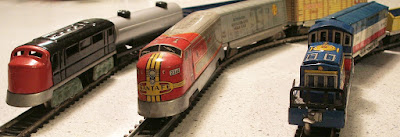 |
| Front to rear: Straco, Cragstan (?), and Bandai sets |
If anyone has any info about these sets, I'd love to see it!
In the meantime, here's a comparison of the three sets. All are approximately HO scale, and all three operate off a battery power pack. The Bandai set consists of a diesel, a tank car, a gondola car, and a caboose. The Cragstan(?) set (I'm not sure it is Cragstan) is made up of a diesel engine and two box cars. The Straco set has a fairly detailed diesel switcher, a box car, gondola car, and caboose. Here's how they stack up.
 |
| Cragston(?) diesel (top) and Bandai diesel (bottom) |
While the Cragstan diesel is more proportionally accurate, the Bandai engine required more involved manufacture. Cragstan's engine is basically a flat surface with applied lithography. Although it's not very clear from the photo, the Bandai has windows punched in the frame, as well as embossed detail. Both have a two-part body assembly (although it's easier to see where the nose section attaches on the Bandai piece).
 |
| Bandai gondola (top and Straco gondola (bottom) |
As you can see, the Straco cars are shorter than those in the Bandai set. It's difficult to say which was more expensive to manufacture. The Bandai car has the entire frame painted black, including the interior. The blue sides have raised details stamped into the metal. The Straco car has flat sides but is lithographed both inside and out. Plus the ends are a more complicated folded metal shape.
 |
| Bandai caboose (top) and Straco caboose (bottom) |
As handsome as most of the Straco set is, the caboose almost looks like an afterthought, especially when compared to the Bandai version. Both have bent ends, but the Bandai caboose has punched out sections to better simulate railing. The Straco caboose has smooth sides and roof for easier application of the graphics, while the Bandai used a stamper to provide detail (and open windows). It seems to me that if Bandai was contracted to produce the Straco set, they could have saved money by reusing the frame of their older caboose, and just putting a smooth metal body on top of that.
So are these three sets all products of the same company, or do they all have different sources?
#Straco







